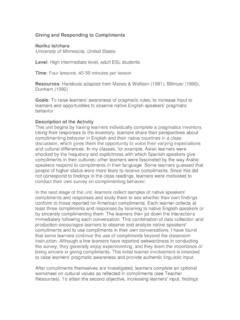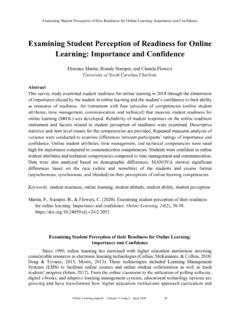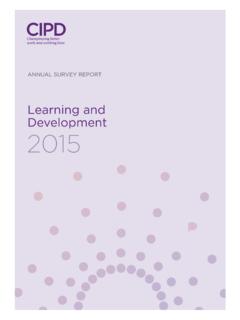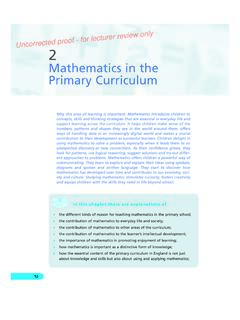Transcription of Disaster Preparedness and Response Training TM
1 Disaster Preparedness and Response TrainingTM Complete Course: Modules One, Two, & ThreeTM Facilitator s GuideTM 2014 National Center for Environmental Health Centers for Disease Control and Prevention Suggested Citation: Centers for Disease Control and Prevention (CDC). Disaster Preparedness and Response : Complete Course. Facilitator guide, first edition. Atlanta (GA): CDC; 2014. For additional information, please contact: Centers for Disease Control and Prevention Environmental Hazards and Health Effects Health Studies Branch 4770 Buford Highway, MS F-60 Chamblee, GA 30341 Phone: + 1 770-488-3410 Fax: + 1 770-488-3450 TABLE OF CONTENTS Course Overview .. i Course Design .. i Target audience .. i Options for Facilitating this Training .. ii Facilitator/Mentor Role and Responsibilities .. ii Icon Glossary .. iii Glossary of terms .. iv MODULE ONE: EPIDEMIOLOGIC Response TO DISASTERS Overview of Module One Epidemiologic Response to Disasters.
2 4 Learning Objectives .. 5 Estimated Completion Time .. 5 Prerequisites .. 5 Lesson 1: Public Health Implications of Disasters and Hazards .. 6 Introduction .. 6 Common Types of Disasters .. 7 Effects of Disasters ..12 Disaster -Related Health Effects and Public Health ..15 Public Health Concerns Following a Disaster ..17 Practice Exercise ..20 Lesson 1 summary ..26 Lesson 2: The Role of Disaster Epidemiology in Disaster Preparedness and Response . 27 Introduction ..27 Goals of Disaster Epidemiology ..28 The Disaster Cycle ..28 The Role of an Epidemiologist in Disaster Preparedness and Response ..30 Special Considerations for Disaster Epidemiology ..37 Practice Exercise ..40 Lesson 2 Summary ..42 References ..43 MODULE TWO: Disaster Response RAPID NEEDS ASSESSMENT Overview of Module Two Disaster Response Rapid Needs Assessment ..51 Learning Objectives ..52 Estimated Completion Time ..52 Prerequisites ..52 Lesson 1: Planning a Disaster Response Rapid Needs Assessment (RNA).
3 53 Introduction ..53 Overview of RNA Methodology ..54 Four Phases of an RNA ..55 RNA Purpose and Objectives ..57 Challenges to Conducting an RNA ..60 Planning for an RNA ..63 Practice Exercise ..67 Lesson 1 Summary ..69 Lesson 2: Phase 1 Preparing for an RNA ..70 Introduction ..70 Overview of RNA Sampling Method ..71 Determine the Assessment Area ..71 Two-Stage Cluster Sampling Method ..74 Considerations Affecting Sample Selection and Size ..78 Other Sampling Methods ..78 Practice Exercise ..82 Develop the RNA Questionnaire and Forms ..83 Identify and Train Field Interview Teams ..89 Conducting the Interview ..91 Practice Exercise ..95 Lesson 2 Summary ..96 Lesson 3: Phase 2 Conducting an RNA ..97 Introduction ..97 Administering the Questionnaire in the Field ..97 Practice Exercise .. 101 Lesson 3 Summary .. 102 Lesson 4: Phase 3 and 4 Data Entry, Analysis, and Writing the 103 Introduction .. 103 Data Entry and Analysis .. 104 Reporting the 114 Practice Exercise.
4 118 Lesson 4 Summary .. 119 Skills Assessment .. 120 Rapid Needs Assessment (RNA) Case Study: Flooding in Guatemala .. 120 Learning Objectives .. 120 Case Scenario .. 120 References .. 135 MODULE THREE: Disaster SURVEILLANCE METHODS Overview of Module Three Disaster Surveillance 144 Learning Objectives .. 145 Estimated Completion Time .. 145 Prerequisites .. 145 Lesson 1: Overview of Disaster Surveillance .. 146 Introduction .. 146 Defining Disaster Surveillance .. 147 Disaster Surveillance: Morbidity and Mortality Considerations .. 150 Surveillance Challenges in a Disaster Setting .. 152 Lesson 1 Summary .. 155 Lesson 2: Disaster Surveillance Methods .. 156 Introduction .. 156 Planning for Disaster 157 Steps for Designing and Conducting a Disaster Surveillance System .. 158 Considerations for Designing or Using Existing Surveillance Methods .. 163 Surveillance Methods .. 165 Disaster Surveillance Indicators and Data Collection Forms .. 167 Practice Exercise.
5 171 Lesson 2 Summary .. 173 Skills Assessment .. 174 References .. 176 i COURSE OVERVIEW The Disaster Preparedness and Response Training Course has three modules. The course also has a final comprehensive capstone activity where learners apply the knowledge and skills learned in the course. After completing all three modules, you will have a better understanding of the Disaster -related rapid needs assessments and surveillance necessary to support responses to disasters and other public health emergencies. Each module builds on the skills and concepts learned in the previous modules. The modules should be completed consecutively in the following order: Module One Epidemiologic Response to Disasters Module Two Disaster Response Rapid Needs Assessment Module Three Overview of Disaster -related Morbidity and Mortality Surveillance COURSE DESIGN The course uses a self-paced, learner-focused format. The majority of the instructional content for the module is contained in a Participant Workbook.
6 learners will read through the Participant Workbook individually and stop at specified points to discuss key points and practice exercises with a mentor or a facilitator. This self-paced format allows learners to complete the Training at their own pace. It is expected that a mentor or facilitator will meet with the learner(s) periodically to review key points and address any questions. It is up to the learner and the facilitator to schedule meeting times. Depending on the number of learners , the facilitator might wish to schedule group sessions or meet individually with each learner. This Facilitator Guide provides suggestions on how to facilitate discussions with learners around key concepts and lessons learned. The Facilitator Guide also provides suggested answers for the practice exercises and case studies included throughout the course TARGET AUDIENCE The target audience is 2nd year Field Epidemiology Training Program (FETP) residents (fellows) and alumni, as well as other health professionals associated with ministries of health who are responsible for Disaster Preparedness and Response initiatives.
7 Ii OPTIONS FOR FACILITATING THIS Training Training can be assisted in two ways: 1. Individual mentor-directed A mentor helps the learner complete the Training . The mentor s main responsibility is to review the learner s work and provide feedback. A mentor meets with the learner a minimum of two times. At the first meeting, the mentor orients the learner to the Training , provides examples and directions indicated, answers questions, and sets future modes of contact and meeting time(s). Very small groups (fewer than five learners ) may choose to work on the Training together and find individual or collective mentors. 2. Classroom Classroom Training can be conducted in two ways. The first way is for learners to read the Training material before attending class and then review in class what they read, the second is for learners to read the Training material during class. a. learners read Training material before attending class. At the start of each module, the facilitator reviews key points.
8 The facilitator may prepare PowerPoint slides for a brief presentation of key points (a draft deck of slides is provided), lead an informed discussion about the reading, or ask learners about what they read and answer questions individually or in small groups (Appendix B contains sample questions). After each review, learners will complete practice exercises and skills assessments as directed. b. learners read Training material during class. The facilitator directs learners to read the Training material and complete the exercises as indicated in the workbook. The facilitator leads group discussions to review what learners have read and reviews learners answers to the exercises and skill assessments. FACILITATOR/MENTOR ROLE AND RESPONSIBILITIES As a facilitator or mentor, you will help in the learning process. Your primary role will be to do the following: Schedule time to meet with learner(s) to discuss Training topics and exercises Introduce the module and lesson topics Lead discussions to review or elaborate on content in the Participant Workbook Answer questions that learners might raise as they read the Participant Workbook Review and discuss learners answers to practice exercises and case study questions, and provide feedback.
9 Summarize the key learning points for each lesson Ensure learners complete the modules in a timely manner You will also have an additional responsibility to play a more active role in supporting learners with their field work after the Training . iii ICON GLOSSARY Throughout the Facilitator Guide, the following icons will help you navigate quickly to relevant sections. Red Boxes Areas highlighted in RED will help guide you by providing instructions, suggested timeframes for each activity, and key content to read to the learners . Light bulb Key idea or lesson learned that you should emphasize for learners Stop A point at which the participant should consult a mentor or wait for the facilitator for further information or instructions [BLUE in participant workbook, RED in instructor guide] Check Knowledge checks that learners should complete. Typically at the end of each section Pencil Practice exercise or case study that learners should complete iv GLOSSARY OF TERMS Active Surveillance Surveillance that employs staff members to contact regularly health care providers or the population to seek information about health conditions.
10 Assessment Area The geographic area that makes up the sampling frame in an epidemiologic study. Case Definition A set of standard criteria for classifying whether a person has a particular disease, syndrome, or other health condition. A case definition frequently includes criteria for person, place, and time and often includes inclusion criteria (characteristics that a person must have if they are to be included) and exclusion criteria (characteristics that disqualify a person from inclusion). A case definition can also include the degree of certainty in a diagnosis ranging from confirmed, probable, to suspected. Cluster Accessibility The ability to enter a given selected cluster to complete interviews. Difficulty in accessibility may arise due to storm damage, unsafe conditions, or restricted entries. Communicable Disease An infectious disease transmissible from person to person by direct contact with an affected individual, the individual's discharges, or by indirect means.


















